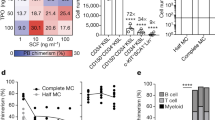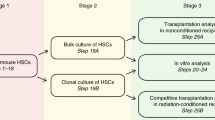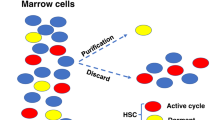Abstract
THE spleen-colony assay of Till and McCulloch1, which is a clonal assay2, measures the content of haemopoietic cells in blood-forming tissues. Stem cells (colony forming units in spleen, CPUS) form red cells, granulocytes, platelets and themselves (self-renewal) in these colonies3,4. Worton et al.5 reported that stem cells separated by velocity sedimentation differed in their capacity for self-renewal. Schofield and Lajtha6 reported that CPUS from mice treated with iso-propyl methane sulphonate have a low self-renewal capacity. We have studied the functional capacity of myeloid stem cells from normal mice (NBM) and mice treated with hydroxyurea. CPUS from mice treated with five injections of hydroxyurea (5 HUBM, G.S.H. and N. M. Blackett, unpublished) formed 3 times more CPUS and 2.5 times more colony forming units in culture per original colony (CFUC, a committed precursor of granulopoiesis7) than those from NBM. When these grafted CPUS were retransplanted they still formed three times more CFUC and CPUS per secondary colony than those from NBM (Tables 1 and 2).
This is a preview of subscription content, access via your institution
Access options
Subscribe to this journal
Receive 51 print issues and online access
$199.00 per year
only $3.90 per issue
Buy this article
- Purchase on Springer Link
- Instant access to full article PDF
Prices may be subject to local taxes which are calculated during checkout
Similar content being viewed by others
References
Till, J. E., and McCulloch, E. A., Rad. Res., 14, 213–222 (1961).
Becker, A. J., McCulloch, E. A., and Till, J. E., Nature, 197, 452–454 (1963).
Fowler, J. H., Wu, A. M., Till, J. E., McCulloch, E. A., and Siminovitch, L., J. Cell Physiol., 69, 65–72 (1967).
McCulloch, E. A., and Till, J. E., Rad. Res., 22, 383–397 (1963).
Worton, R. G., McCulloch, E. A., and Till, J. E., J. exp. Med., 130, 91–103 (1969).
Schofield, R., and Lajtha, L. G., Br. J. Haemat., 25, 195–202 (1973).
Bradley, T. R., and Metcalf, D., Aust. J. exp. Biol. Med. Sci., 44, 287–300 (1966).
Hodgson, G. S., Bradley, T. R., Martin, R. F., Sumner, M., and Fry, P., Cell Tissue Kinet., 8, 51–60 (1975).
Hodgson, G. S., Bradley, T. R., and Telfer, P. A., Cell Tissue Kinet., 5, 283–288 (1972).
Author information
Authors and Affiliations
Rights and permissions
About this article
Cite this article
ROSENDAAL, M., HODGSON, G. & BRADLEY, T. Haemopoietic stem cells are organised for use on the basis of their generation-age. Nature 264, 68–69 (1976). https://doi.org/10.1038/264068a0
Received:
Accepted:
Issue Date:
DOI: https://doi.org/10.1038/264068a0
This article is cited by
-
Polycomb group proteins in hematopoietic stem cell aging and malignancies
International Journal of Hematology (2011)
-
Regulatory pathways in blood-forming tissue with particular reference to gap junctional communication
Pathology & Oncology Research (2000)
-
Generation age as a factor determining the use of hematopoietic stem cells
Bulletin of Experimental Biology and Medicine (1983)
-
Effect of hydroxyurea on two different types of hematopoietic stem cells (CFU-S and DCPC) of newborn mice
Blut (1981)
-
Properties of haematopoietic stem cells surviving 5-fluorouracil treatment: evidence for a pre-CFU-S cell?
Nature (1979)
Comments
By submitting a comment you agree to abide by our Terms and Community Guidelines. If you find something abusive or that does not comply with our terms or guidelines please flag it as inappropriate.



